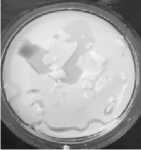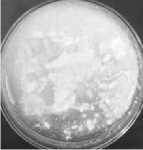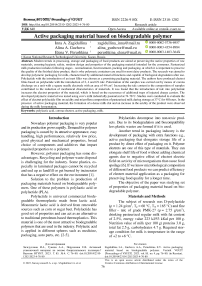Active packaging material based on biodegradable polymer
Автор: Zagidullina I.A., Guzhova A.A., Perushkina E.V.
Журнал: Вестник Воронежского государственного университета инженерных технологий @vestnik-vsuet
Рубрика: Пищевая биотехнология
Статья в выпуске: 4 (98) т.85, 2023 года.
Бесплатный доступ
Modern trends in processing, storage and packaging of food products are aimed at preserving the native properties of raw materials, ensuring hygienic safety, modern design and properties of the packaging material intended for the consumer. Pasteurized milk production includes following stages - normalization, heat treatment, packing and packaging, at which it is important to preserve the quality of the finished dairy product, that is why polymeric containers are used for most dairy products. The research was aimed to develop polymeric packaging for milk, characterized by additional material functions and capable of biological degradation after use. Polylactide with the introduction of an inert filler was chosen as a promising packaging material. The authors have produced electret films based on polylactide with the introduction of 2, 4 and 6% talc. Polarization of the samples was carried out by means of corona discharge on a unit with a square needle electrode with an area of 49 cm2. Increasing the talc content in the composition of samples contributed to the reduction of mechanical characteristics of materials. It was found that the introduction of talc into polylactide increases the electret properties of the material, which is based on the occurrence of additional traps of injected charge carriers. The developed polymeric material was tested using cow's milk industrially pasteurized at 74-76°C. Studies were conducted to evaluate the effect of electret polylactide film on acidity and microflora composition of pasteurized milk during storage at 37°C for 48 hours. In the presence of active packaging material, the formation of a dense milk clot and an increase in the acidity of the product were observed during the milk fermentation.
Polylactic acid, corona electret, active packaging, milk
Короткий адрес: https://sciup.org/140304451
IDR: 140304451 | УДК: 640 | DOI: 10.20914/2310-1202-2023-4-76-80
Текст научной статьи Active packaging material based on biodegradable polymer
Nowadays polymer packaging is very popular and its production grows rapidly. Demand for polymer packaging is caused by its attractive appearance, easy handling, high performances, relatively low price, good physical and mechanical properties, broad choice of components and additives that impart required properties to a polymer.
However, polymer packaging has some disadvantages. Recycling and polymer waste disposal is challenging for the industry. Some plastics, especially in laminated packages cannot be recycled and end up as landfill or get burned by incinerator that has a negative effect on the environment [1].
Solution to the problem is production of packaging materials based on biodegradable polymers. One of these polymers is polylactic acid or polylactide (PLA).
Polylactide is universal commercial biodegradable thermoplastic made from lactic acid. Monomeric lactic acid is derived from renewable sources such as corn or sugar beet. Polylactide has good set of properties and can act as an alternative to traditional petroleum-based thermoplastics. This material is one of the most attractive biodegradable polymers that are used in the industry. Polylactic acid is applied in different spheres such as medicine, packaging, auto parts, etc. [2-5].
Polylactides decompose into non-toxic products. Due to its biodegradation and biocompatibility less plastic wastes are formed if it is used.
Another trend in packaging industry is the development of packaging with extra functions e.g., active packaging that elongates storage life of a product by direct effect of packaging on it. Polymer electrets are one of this type of materials. They can elongate shelf life of food without adding chemical agents due to negative effect of electret electric field on activity of microorganisms that cause food spoilage [6]. If we know microbiological composition of different food products we can predict efficiency of electret material application as a packaging for preserving food quality for a longer time.
The objective of the paper was studying set of properties of packaging material based on biodegradable polymer.
Materials and Methods
The subject of research was D-polylactide (ρ = 1.24 g/сm3, Т g = 60 °C, Т m = 165 °C) and fine filler – tаlс of grade PMK-27 (ρ = 2.75 g/сm3), drinking pasteurized regular milk with fat content of 2.5%, energy value 223 kJ/53 kКаl per 100 g. Nutrition value of milk (per 100 g) proteins 3.0 g, total fat 2.5 g, carbohydrates 4.7 g. Required storage condition for milk is temperature in the range of +2 to +6 °C.
This is an open access article distributed under the terms of the Creative Commons Attribution 4.0 International License
Polylactide and tаlс were mixed with Brabender Mixer W 50 EHT. Mixing was done at a temperature of 180 °С during 300 s at 150 rpm blades rotation.
Sample films with thickness of 0.5 mm were formed with Gotech GT-7014-Н10С according to GOST 12019–66 (Russian Standart).
The films were charged with two-electrode negative corona discharge system. Upper charging electrode consisted of 196 sharp needles uniformly distributed in the shape of a square with a side of 7 cm. Distance between a sample and the electrode was 20 mm. Polarization time was 30 s, polarization voltage was 30 kV.
Surface potential V s , electric field strength Е and effective surface charge density σ eff were measured with IPEP-1 fieldmeter.
Stress-strain behavior of the material was studied according to GOST 11262–80 with universal testing machine Test Р 108.
Samples of packaging materials in the shape of a square with a side of 6 cm pretreated with 3% hydrogen dioxide solution were placed into pasteurized milk complying sterility conditions. To assess biofilm formation polymer samples were kept in milk at a temperature of 37 ºС for 48 hours. After holding in a thermostat milk samples were examined and milk visual appearance was registered (presence of curd, whey formation, presence of milk flakes). Reference sample group was milk in sterile Petri dishes without packaging material. The results given below were an average of three replications.
To determine lactic acid bacteria activity during milk souring titrable acidity was measured that was expressed in Turner degrees (ºТ). Microbiological study of biofilm of the milk microflora on the surface of the packaging materials was carried out after condition samples at 37 °C for 48 hours followed by washing with sterile physiological solution of 0.9% NаСl. Inoculation was done on beef-extract agar nutritive medium by the method of replica plating. Before microscopic analysis plates were incubated at 37 °C for 72 hours.
Results
Surface potential V s , electric field strength Е and effective surface charge density σ eff of PLA-talc compositions showed similar behavior pattern (Table 1). Talc content growth gradually increased electret properties, which reached maximum at 4% talc loading, followed by slight fall at higher filler content. So, composition of polylactide and 4 vol.% talc had the highest and the most stable electret properties.
Table 1.
Electret properties of PLA-talc compositions on 60th day after charging
|
Sample |
V s , kV |
Е, kV/m |
σ eff , µC/m2 |
|
PLA 100% |
0.3 |
19.97 |
0.15 |
|
PLA + 2% talc |
0.43 |
27.93 |
0.25 |
|
PLA + 4% talc |
0.52 |
39.07 |
0.35 |
|
PLA + 6% talc |
0.39 |
26.67 |
0.20 |
Stress-strain behavior is important parameter for polymer packaging. Table 2 illustrates that talc addition slightly reduced performance of the material.
Table 2.
Stress-strain behavior of PLA-talc compositions
|
Sample |
σ UTC , MPa |
ε,% |
|
PLA 100% |
47.60 |
7.50 |
|
PLA + 2% talc |
42.98 |
5.13 |
|
PLA + 4% talc |
41.49 |
4.53 |
|
PLA + 6% talc |
50.51 |
6.13 |
Titrable acidity is an indicator of milk quality and bacterial counts (table 3).
Table 3.
Milk acidity (ºТ) during conditioning at a temperature of 37 ºС in the presence of polymer packaging materials
|
Sample |
Cultivation duration, h |
||
|
0 |
24 |
48 |
|
|
Reference (pasteurized milk) |
16 ± 2 |
67 ± 4 |
125 ± 4 |
|
Polyethylene |
16 ± 2 |
29 ± 4 |
101 ± 5 |
|
PLA |
16 ± 2 |
36 ± 3 |
109 ± 2 |
|
PLA + 4% talc (electret) |
16 ± 2 |
78 |
108 ± 3 |
When active polylactide packaging was inserted in milk, dense milk curd was formed during the process of milk souring at a temperature of 37 ºС (figure 1). When polyethylene and uncharged polylactide films were used, small curds and milk protein flakes were formed (figure 2).

Figure 1. Milk curd in the presence of electret polylactide + 4% talc packaging

Figure 2. Milk curd in the presence of untreated polylactide packaging
Discussion
Electrets are dielectric materials that keep polarization state (ordered reorientation of molecules in the substance or material) even without external electric field. Electret properties of polymers depend on multiple factors – type of a polymer, polarization parameters, storage conditions, etc. Polylactide charges badly by the method of the corona discharge. However, electret properties of a polymer can be enhanced by filler loading and production of polymer composite materials.
To improve polylactide electret properties fine talc was added. It was chosen due to its availability and suitability for food industry. Talc loading into the polymer resulted in higher and more stable electret properties (Table 1) that is consistent with the previous research [7, 8].
Slight reduction of stress-strain properties when talc was loaded into the polylactide can be caused by the fact that talc particles do not deform together with polymer matrix due to great difference in their elasticity moduli. It resulted in appearance of new cracks and overstresses at polymer-filler interface boundary and loosened composite material.
The best electret properties were shown by composition of PLA and 4% talc. That’s why this composition was chosen for the study of the material as the milk packaging.
Dairy product quality, economic efficiency of production and food industry sustainability depend largely on bacterial contamination of a feedstock and contact surfaces throughout all production stages. Bacterial biofilms emerge in all stages of milk production during 12 hours. Bacillus cereus and Enterococcus faecalis are the most common microorganisms contaminating surfaces of the equipment and form dense biofilms [9--12].
Presence of the biofilms in milk medium affects storage life of the final products and, therefore, we were interested in the aspects of bacterial colony development on the surface of packaging materials in the context of food hygiene.
Ability of microorganisms to attach and grow on food and food-contacting surfaces under favorable conditions gains special interest. Biofilm formation is a dynamic process; attachment and growth require different mechanisms. If microorganisms are not completely removed from foodcontacting surfaces, it may give rise to biofilm formation and increases boitransfer potential [13-17].
The right choice of packaging material and its cleaning and disinfection method positively affects biocontrol and biofilm formation, that provides quality and safety of food.
Microbial diversity of biofilms was estimated by culture-dependent method. Microscopic examination of inoculated biofilm samples from the surface of packaging materials revealed differences in morphological structure of the film. Samples from the surfaces of standard commonly-used polyethylene and untreated polylactide had prevailing sporogenic rod-shaped bacteria that formed on the nutritive medium white colonies with folded center and undulate margin. These are representatives of putrefactive aerobic bacteria Bacillus that cause food spoilage when stored under aerobic conditions. Sporogenic rod-shaped bacteria have proteolytic power and peptonize milk.
Bacteria associated with milk fermentation were dominating on the surface of active polylactide packaging material. Typical representatives of milk microflora were revealed – gram-positive cocci arranged in pairs or chains, asporous non-motile gram-positive rods arranged in pairs or chains. Lactic acid bacteria colonies dominated in microbiota of the biofilms, with minor presence of sporogenic bacteria and gram-negative rod-shaped bacteria. Well-known microorganisms that cause milk spoilage at production site include such bacteria as Bacillus (predominantly B.cereus ) and Pseudomonas. Pseudomonas strains can form biofilm in dairy products at 30 °С in 48 hours of incubation [18-22].
The obtained microscopic results are compliant with high acidity of milk in the presence of electret polylactide packaging. It wаs78ºТ at 24th hour and at the end of the experiment this value was 109ºТ (Table 3). It is due to lactic acid bacteria growth is accompanied by lactose fermentation and lactic acid formation. Titrable acidity reduction by 14% compared to reference milk samples was registered.
Milk acidity growth of biofilms on polyethylene packaging was slow (29 ºТ at 24th hour of conditioning) that is related to prevailing of putrefactive sporogenic bacteria in the community and replacement of typical lactic acid bacteria. Initial pasteurized milk acidity was 16ºТ that corresponds to regulatory requirements.
Dense milk curd formed during the process of milk souring in the presence of electret polylactide + 4% talc packaging (figure 1) was the product of lactic acid bacteria activity, while small curds and milk protein flakes (figure 2) indicated growth of microorganisms that cause food spoilage.
Therefore, electric field of the electret packaging material inhibited growth of bacteria contaminating dairy production.
Conclusion
Thus, electret material prevented activity of saprogenic bacteria on its surface, while biofilm with prevailing lactic acid bacteria was formed. Dense milk curd formation was registered at conditioned milk souring that corresponded to high milk acidity.
Active electret packaging based on composition of polylactic acid and talc preserves natural flora of pasteurized milk and prevents growth of microorganisms that spoil food.
Список литературы Active packaging material based on biodegradable polymer
- Pantyukhin O.V., Komarov D.V., Pantyukhina E.V. Modern aspects of recycling polymer packaging. News of Tula State University. Geosciences. 2022.vol. 4. pp.128-133. (in Russian)
- Gulyakova A.A., Galikhanov M.F., Ma X., Zhang X. et al. The Peculiarities of Electret Effect in Corona Electrets Based on Nonpolar and Polar Polymers with Dispersed Montmorillonite. IEEE Transactions on Dielectrics and Electrical Insulation. 2022. vol. 29. no. 3. pp. 840-844. doi:10.1109/tdei.2022.3178093
- Kovalenko M.A., Zotov S.V., Goldade V.A., Pavlov A.A. et al. Electret state in nanocomposites based on polylactide. Problems of physics, mathematics and technology. 2023. no. 2(5). pp. 20-24. doi: 10.54341/20778708_2023_2_55_20
- Volokhova A.A. et al. Reactive Magnetron Plasma Modification of Electrospun PLLA Scaffolds with Incorporated Chloramphenicol for Controlled Drug Release. Polymers. 2022. vol. 14. no. 3. pp. 373. doi: 10.3390/polym14030373
- Dobrosielska M. et al. Effect of wax additives and silanization of diatom surfaces on thermomechanical properties of polylactide composites. Polymers. 2022. vol. 14. no. 24. pp. 5511.
- Galikhanov M. Corona Electrets Based on Filler-Loaded Polymers: Structure, Properties, and Applications. IEEE Transactions on Dielectrics and Electrical Insulation. 2022. vol. 29. no. 3. pp.788-793. doi: 10.1109/TDEI.2022.3159841
- Galikhanov M., Guzhova A., Zagidullina I. Improvement of Electret Properties of Polylactide by Loading Mineral Fillers. IEEE Transactions on Dielectrics and Electrical Insulation. 2022. vol. 29. no. 3. pp. 784-787. doi: 10.1109/TDEI.2022.3173499
- Zagidullina I.A., Galikhanov M.F., Kamalova R.I., Sharipova G.F. et. al. The study of the electret properties of polylactic acid and mineral fillers. AIP Conference Proceedings. 2020. vol. 2313. no. 1. pp. 050048.doi: 10.1063/5.0033479
- Flint S., Bremer P., Brooks J., Palmer J. et al. Bacterial fouling in dairy processing. International Dairy Journal. 2020. vol. 101. pp. 104593.
- Guo R., Li K., Tian B., Wang C. et al. Elaboration on the architecture of pH-sensitive surface charge-adaptive micelles with enhanced penetration and bactericidal activity in biofilms. Journal of Nanobiotechnology. 2021. vol. 19. no. 1. pp. 1-18. doi: 10.1186/s12951-021-00980-8
- Glicerina V., Siroli L., Canali G., Chinnici F. et al. Efficacy of biodegradable, antimicrobial packaging on safety and quality parameters maintenance of a pear juice and rice milk-based smoothie product. Food Control. 2021. vol. 128. pp. 108170. doi: 10.1016/j.foodcont.2021.108170
- Mikloskova H. et al. Storage stability of plain stirred whole milk yoghurt (3.7% fat) packed in polylactic acid and polystyrene. International Dairy Journal. 2021. vol. 120. pp. 105088. doi: 10.1016/j.idairyj.2021.105088
- Lianou D.T., Michael C.K., Solomakos N., Vasileiou N.G. et al. Isolation of biofilm-forming staphylococci from the bulk-tank milk of small ruminant farms in Greece. Foods. 2023. vol. 12. no. 15. pp. 2836.doi:10.3390/foods12152836
- Gajewska J., Chajęcka-Wierzchowska W., Byczkowska-Rostkowska Z., Saki M. Biofilm Formation Capacity and Presence of Virulence Determinants among Enterococcus Species from Milk and Raw Milk Cheeses. Life. 2023. vol. 13. no. 2. pp. 495. doi: 10.3390/life13020495
- Lee J.I., Kim S.S., Kang D.H. Characteristics of Staphylococcus aureus biofilm matured in tryptic soy broth, low-fat milk, or whole milk samples along with inactivation by 405 nm light combined with folic acid. Food Microbiology. 2023. vol. 116. pp. 104350. doi: 10.1016/j.fm.2023.104350
- Ngo T.P., Bui H.L., Pham T.B.N. Identifying biofilm forming bacteria in cow milk in Mekong Delta, Viet Nam. Can Tho University Journal of Science. 2023. vol. 15. no. 1. pp. 84-90. doi: 10.22144/ctu.jen.2023.011
- Rudenko P, Sachivkina N, Vatnikov Y, Shabunin S, Engashev S, Kontsevaya S, Karamyan A, Bokov D, Kuznetsova O, Vasilieva E. Role of microorganisms isolated from cows with mastitis in Moscow region in biofilm formation, Veterinary World, 2021. vol. 14(1). pp. 40-48.
- Ban G.H., Lee J.I., Kang D.H. Effects of storage temperature on microbiota shifts in raw milk biofilm developed on stainless steel. Food Microbiology. 2023. vol. 110. pp. 104163. doi: 10.1016/j.fm.2022.104163
- Diarra C., Goetz C., Gagnon M., Roy D. et al. Biofilm formation by heat-resistant dairy bacteria: multispecies biofilm model under static and dynamic conditions. Applied and Environmental Microbiology. 2023. vol. 89. no. 10. pp. e00713-23. doi: 10.1128/aem.00713-23
- Kiel A., Kaltschmidt B.P., Asghari E., Hütten A. et al. Bacterial biofilm formation on nano-copper added PLA suited for 3D printed face masks. Microorganisms. 2022. vol. 10. no. 2. pp. 439. doi: 10.3390/microorganisms10020439
- Nkemnaso O.C., Chisom O.C. Biofilms and Microbial Mats: Roles in Contamination of Food Industries-A Review.
- Sivanandham V. et al. Biofilm Formation and Persistence in Food Industries: Perspectives on Emerging Control Strategies Prospective Research and Technological Advancements in Food and Health Sciences. 2023. pp. 14-82. doi: 10.22573/spg.023.978-93-90357-07-9/2


